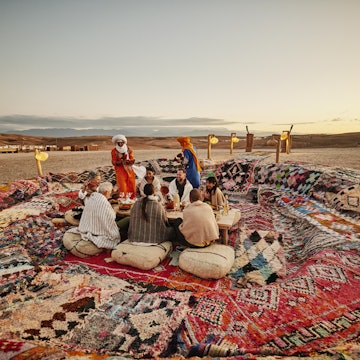
What does the COVID-19 vaccine news mean for your 2021 travel?

Nov 12, 2020 • 5 min read

Where are you dreaming of traveling when it's safe to do so? © MStudioImages / Getty Images
With the announcement of an effective COVID-19 vaccine, aviation journalist John Walton looks into when travellers should expect to be able to get back on the road.
If you weren’t already popping the corks at the news over the last week, the announcement from Pfizer and BioNTech that their first candidate COVID-19 vaccine is 90% effective is reason to celebrate for all of us — and particularly for those of us who are waiting to be able to travel to visit our friends and family, to rest and recharge, and to explore our shared world.
There’s finally some light at the end of the coronavirus tunnel, although there’s still a fair amount of tunnel left before we can get back to traveling responsibly. But after our first celebratory glass of something special at the prospect of science beating this deadly disease, what does it mean for those of us who have been longing to travel all year?
Effectiveness is a question of numbers
The effectiveness of a vaccination campaign is fairly simple mathematics: it’s the number of people vaccinated multiplied by the percentage of people the vaccine stops from getting the disease (its efficacy). Pfizer’s study of nearly 44,000 people is indicating that its vaccine candidate has an efficacy of 90%. A good year for the flu vaccine is around 50%, so this is excellent news — and, even better, there’s potentially more good news to come from other vaccine candidates also in late-stage trials.
How to avoid being a superspreader during the holidays
But don’t forget that, if it’s 90% effective at preventing infection, that’s still one in ten people who may fall ill. You’re unlikely to know which category you fall into, but if you’re one of the unlucky ones, the good news is that the other 90% being vaccinated will mean that there’s a drop in the amount of the virus circulating around you. But that benefit only comes once enough people have been vaccinated that the disease essentially dies out.
What’s more, some countries aren’t intending to vaccinate their entire populations. The UK, for example, has not yet made a decision on vaccinating anyone under 50.

So how will the vaccine impact travel in 2021?
Let’s talk timing: unless you fall into a high-risk group or are a healthcare worker on the front lines of the fight against COVID-19, you should probably expect that you might be able to get a vaccination towards the early or middle end of 2021. That’s because producing this vaccine and distributing it to everyone on the planet is a mammoth task, not least because it requires two injections spaced 21 days apart — meaning that the process for each person will take the best part of a month even after the first vaccination.
It must also be transported and stored at -80°C (-112°F). The extreme temperature creates quite a few complexities in terms of distributing and administering it. Several following candidate vaccines seem to be a bit more tolerant of temperatures — although their efficacy is still being studied — so what we may well end up with is a situation where high-risk groups are initially vaccinated with the early candidate vaccine or vaccines, and other folks with later ones.
And one of the things about COVID-19 in particular is that it has a two-week incubation period, so — as we’re seeing right now in Europe with the various lockdowns and restrictions — decisions made two weeks ago only start to have results after that time delay.
We’ll then need even more time to allow ICUs, hospitals and the rest of our medical systems to decline from their current emergency state, while at the same time they’ll also need to implement the swiftest and most wide-ranging urgent vaccination program ever known to humankind. That’s likely to take months and months, even if everything goes to plan.
What is a ‘travel pod’ and is it the future of vacation travel during the pandemic?
What does that mean for travel? Well, let’s say that vaccinating folks who aren’t medical workers or in care homes starts in January. It’ll take about a month for even people who got their first vaccinations on day 1 to develop immunity. Assuming we’re vaccinating everyone else with the same Pfizer/BioNTech vaccine, that same timescale carries over.
Will we be able to travel as soon as we’re vaccinated?
That’s the key question. It seems almost a no-brainer to allow people who have had their vaccinations and had the time to develop immunity to travel — especially if the 90% efficacy rate holds true. Even more so if the more effective hygiene measures like mask-wearing and social distancing in public remain in place until the vaccination program is complete.
That said, it seems likely that governments will take different approaches both on the principles of the thing and on the details, like how you prove vaccination and so on, so your mileage will almost certainly vary depending on where you’re hoping to travel.
From everything we’ve seen so far this year, it seems likely that some of the countries that depend most on tourism will be keenest to encourage visitors to return. (Not all of them, though: given the success that New Zealand and Australia in particular have seen in largely eradicating COVID-19, I’d expect their restrictions to be among the most stringent.)
Australia and New Zealand's travel bubble opens to emotional scenes
It’s likely that much of the burden for administering this will fall on airlines, in the same way that they’re required to check visa eligibility, and it will be interesting to see how this ends up being done. As a result, when you get your vaccination or vaccinations, I’d recommend you ensure that you go home with signed and dated paperwork that details which vaccine you’ve been administered.
When you can start traveling again will depend on a variety of factors: how many vaccines are successful, how effective they are, how your country rolls out its vaccination effort, how cautious your intended destination remains about the virus, and what more we learn about how it spreads over the next six months or so. But, if all goes well, it feels like we could hope to see a possibility of responsible travel sometime between early and mid 2021. In the meantime, stay safe, stay healthy, keep wearing those masks, and take care of yourself — and each other.
Read more:
How to make sense of Europe's brand new 'traffic light' travel system
A state-by-state guide to travel restrictions in the US
The 6 best video game worlds for travel lovers












